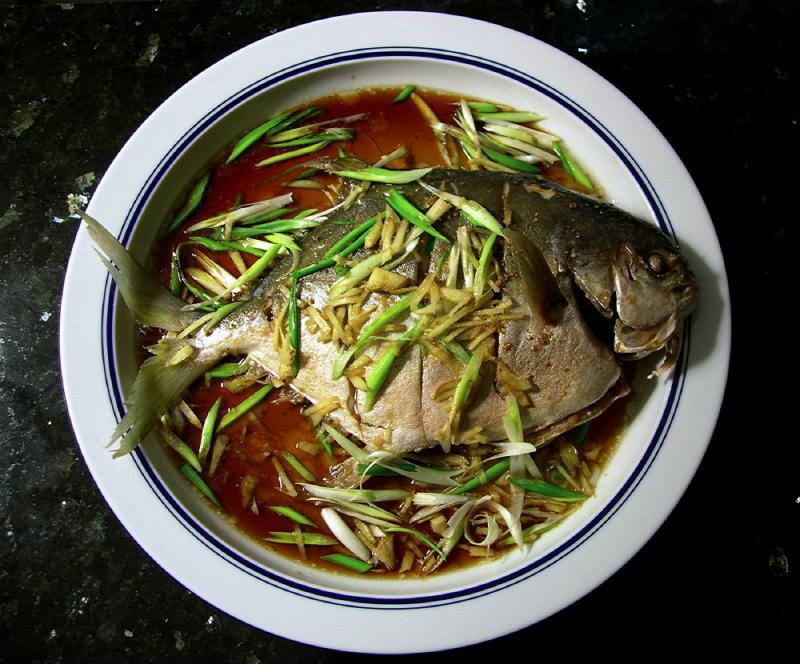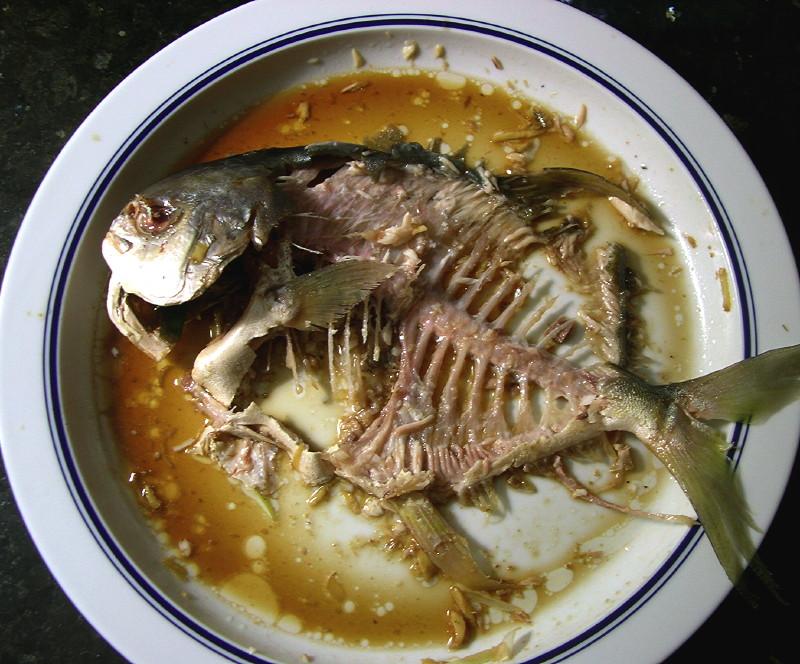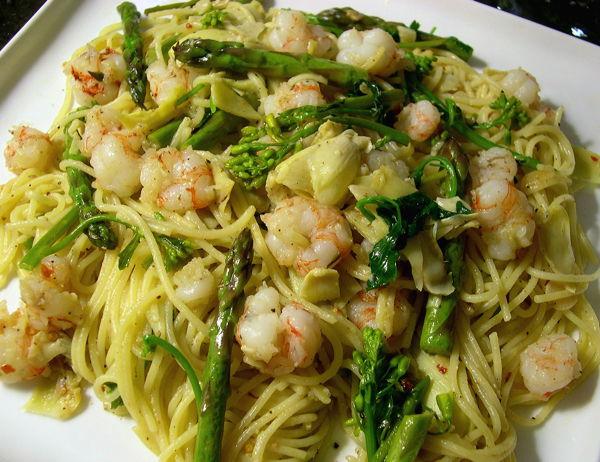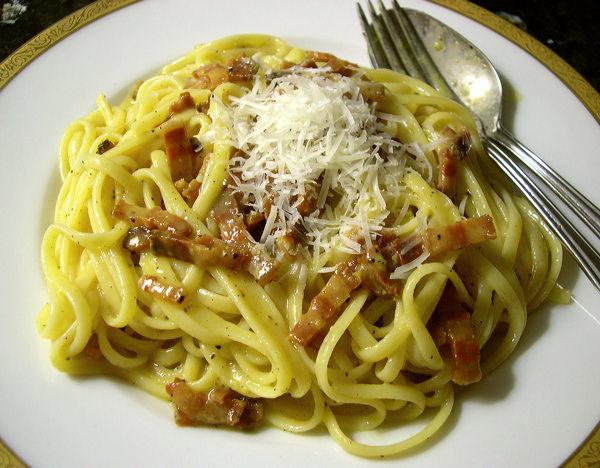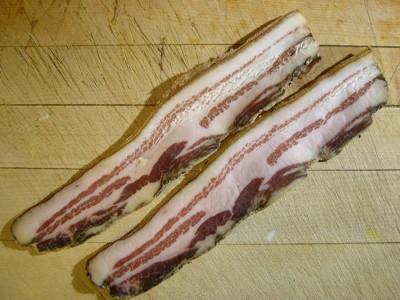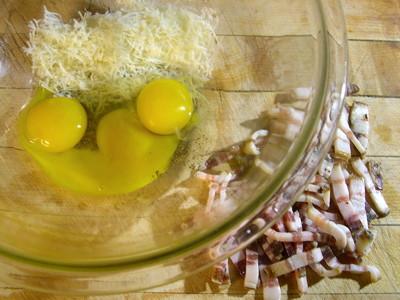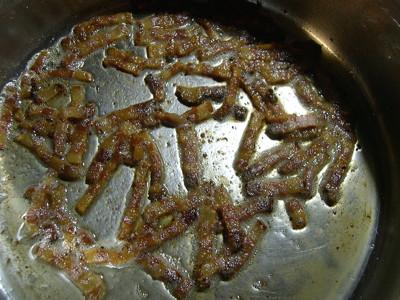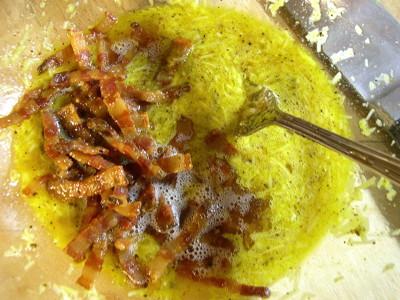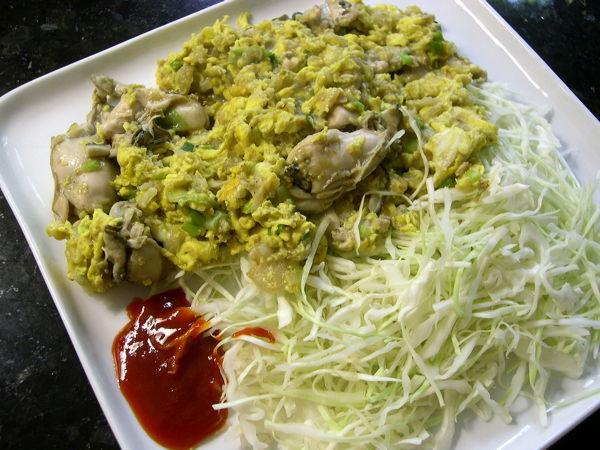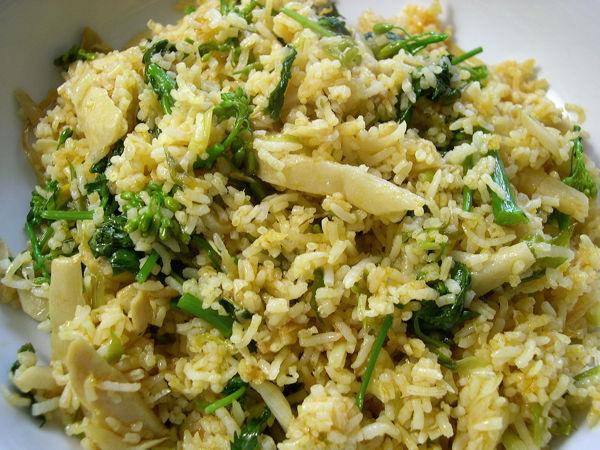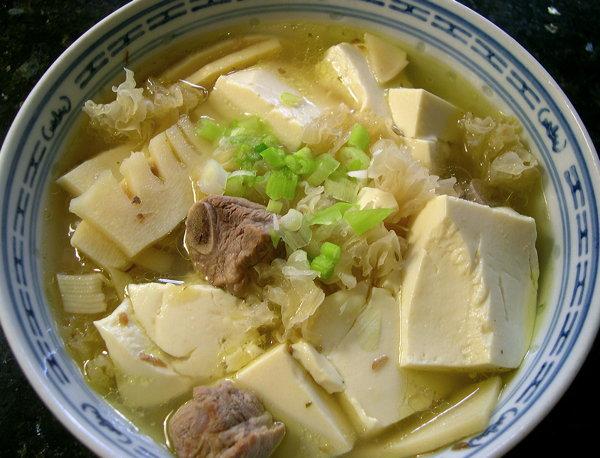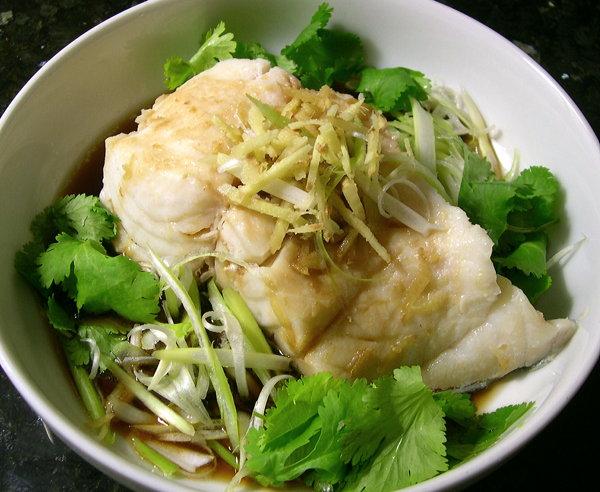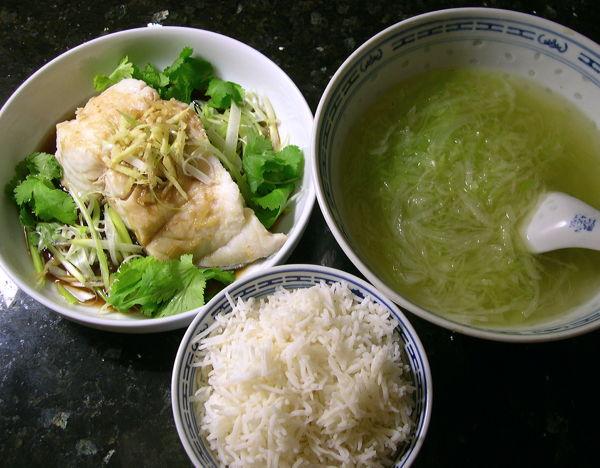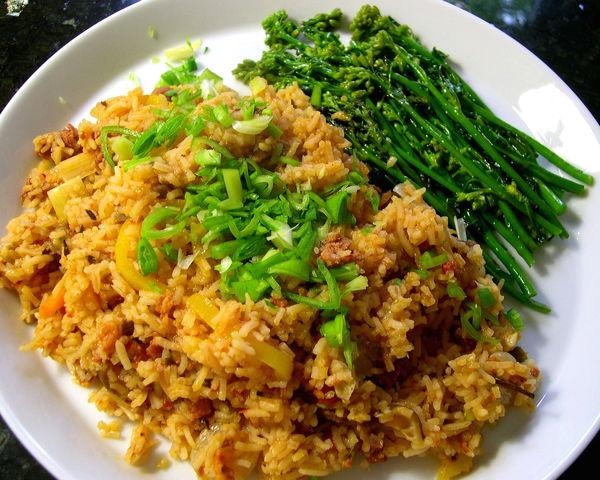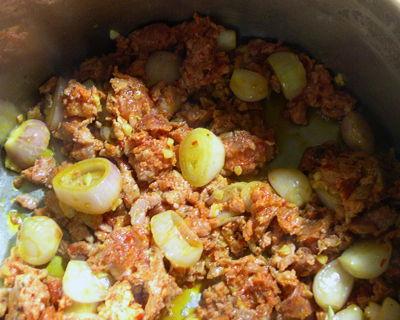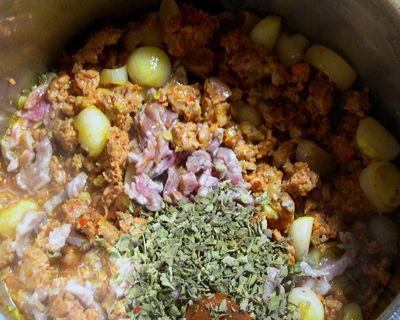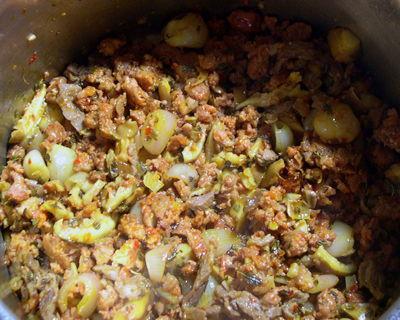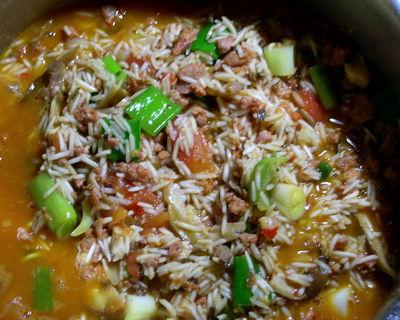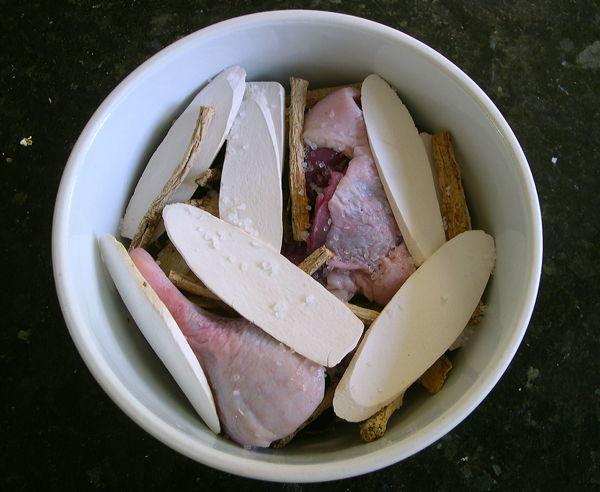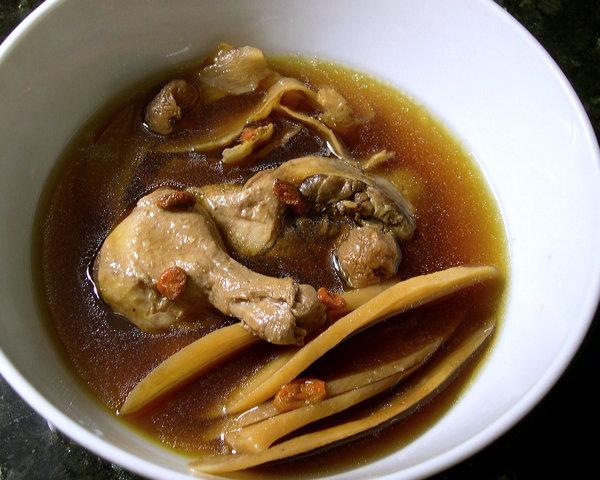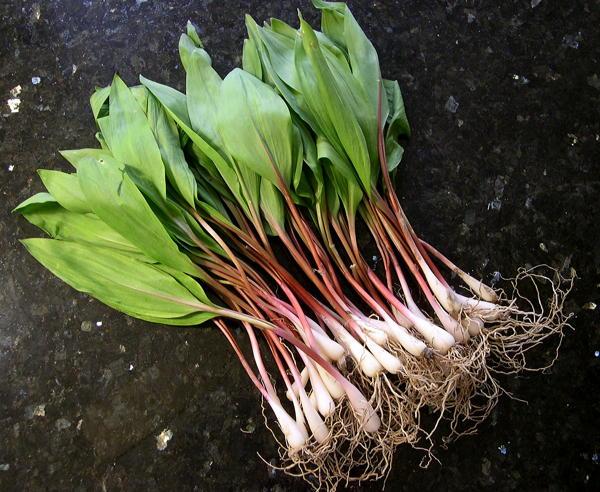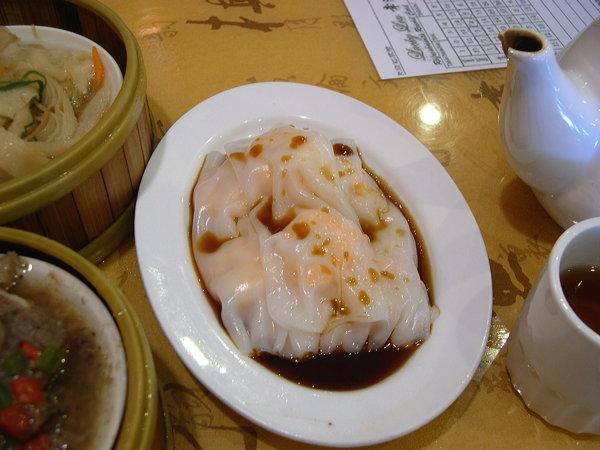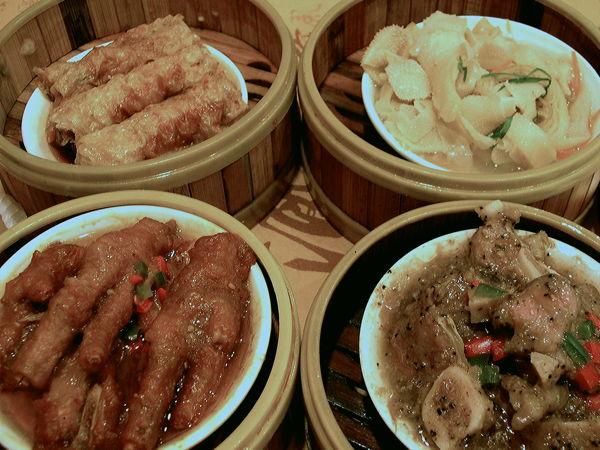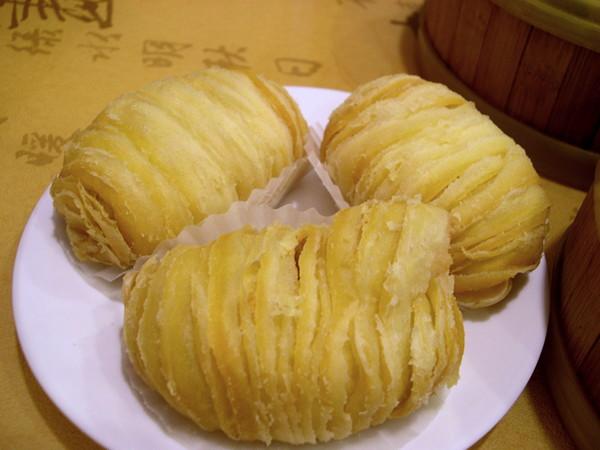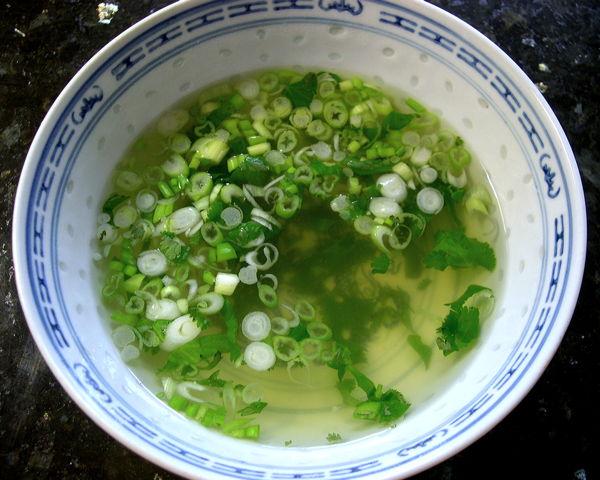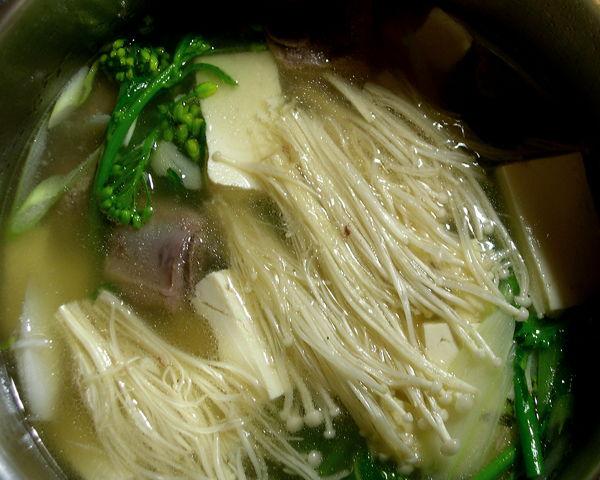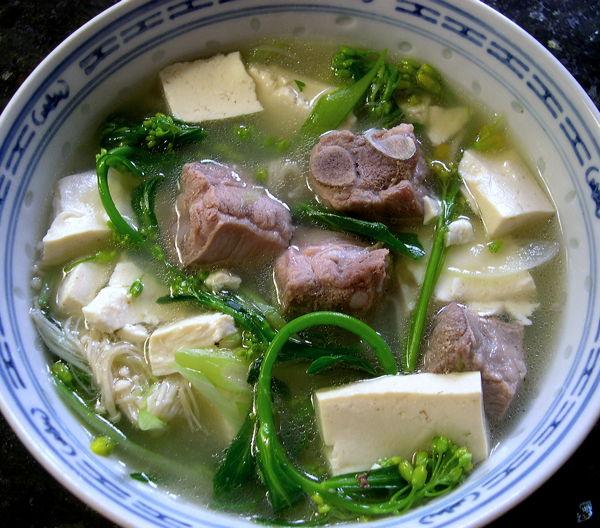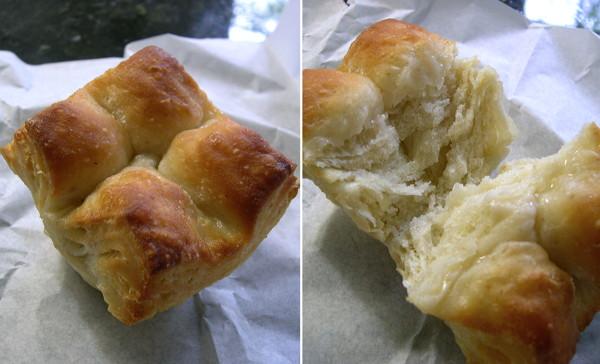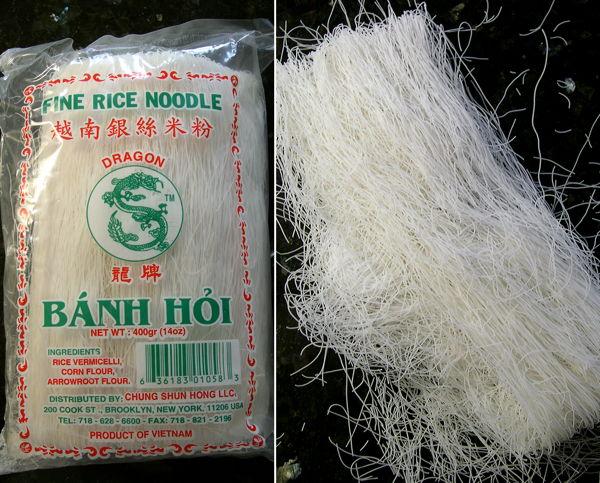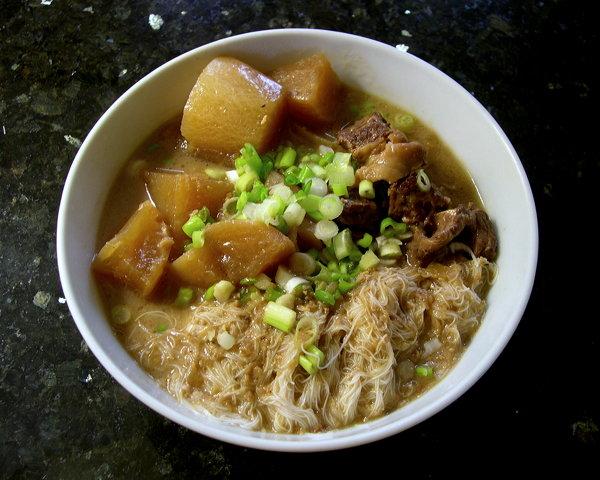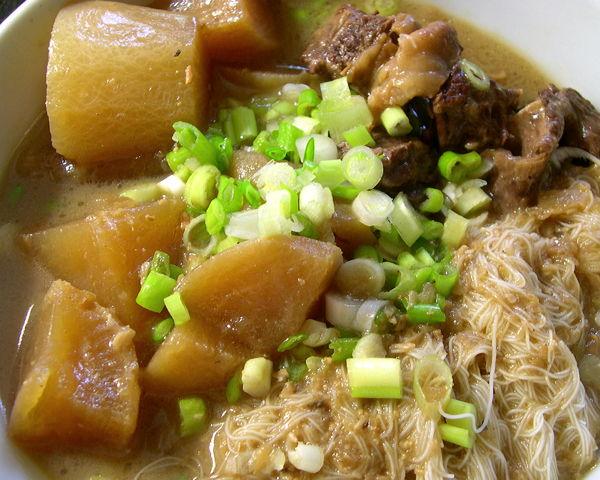-
Posts
3,810 -
Joined
-
Last visited
Content Type
Profiles
Forums
Store
Help Articles
Everything posted by huiray
-
Cantonese-style steamed pompano, before-and-after. :-) (From this post; scroll down) Happily demolished by chopsticks, progressively picking off pieces and sucking on the bones-plus-gelatinous-flesh from the belly region too. (Those belly bones were plucked out from my mouth by chopsticks and deposited on another little saucer, I imagine - I don't remember specifically now. :-D ) ETA: On further reflection I must have flipped the fish shown above after eating the "first side" otherwise the positioning of the initial fish and the bony carcass would not make sense. I've done this in other cases too. Then again, I also "peel off" the backbone/spine plus head in other cases; or break the spine just behind the head then peel off the spine from there to the tail before eating the"bottom half". Yes, if I go after the cheeks then of course I would need to flip the head over in any of the three cases to get both cheeks.
-
Fedelini w/ rock shrimp & stuff. Picked up very nice rock shrimp (Sicyonia brevirostris) from Goose the Market. Half of them went into this dish. Arbequina EV olive oil [California Olive Ranch], a thick slice of butter [Sèvre & Belle Charentes Poitou, demi-sel], sliced garlic (do not brown), peeled & deveined rock shrimp; toss & stir on medium heat till the shrimp are less-than-barely cooked (very quick; faster than "regular" shrimp). Remove shrimp, reserve. Add in hot red chilli flakes, bottom parts of local asparagus, stir a minute; add in halved artichoke hearts (drained) [Vigo], stir. Asparagus tops, parsley leaves, rapini flowers then go in plus several good grinds of black pepper and a splash of AgroDolce Bianco Delizia Estense. Stir everything briefly, then wet just-cooked fedelini (lightly salted cooking water) [De Cecco] goes in followed by the reserved shrimp and everything is tossed & stirred around w/ some of the pasta cooking water added in, for a minute or less. Serve.
- 495 replies
-
- 10
-

-
Linguine Carbonara. Two egg yolks + 1 whole egg [Schacht Farm], grated Pecorino Romano [The Fresh Market], freshly-ground black pepper (lots), stir together; pancetta tesa¶ [Smoking Goose, via Goose the Market] sliced up & gently fried in a pan + the rendered fat, cooled down, stir; dripping wet just-cooked linguine [Rustichella d'Abruzzo] straight from the hot cooking water; immediately stir like crazy.** Plate, top w/ more grated Pecorino Romano. Eat. ** The Pecorino Romano "melts" into the sauce while the hot linguine is vigorously stirred into the sauce mixture, as many folks will know. ¶ I usually use guanciale for this, but the pancetta tesa looked so inviting when I saw it... On the way there:
- 495 replies
-
- 13
-

-
Oh Chien chez huiray, today's version. Served with green cabbage & Lingham's Hot Sauce. Medium-hot pan, peanut oil, batter**, beaten duck eggs, oysters, dash of fish sauce, chopped scallions. ** mixture of rice flour, tapioca starch, water, white pepper, salt, fish sauce. Fried rice. Peanut oil, sliced scallions (lots), shredded bamboo shoots in chilli oil, 2-day-old rice, rapini flowers cut into short lengths.
- 495 replies
-
- 11
-

-
Was it Phở or was it Bún bò Huế ?
-
Soup. Oil, chopped smashed garlic, julienned ginger, shot-cut pork spare ribs, sliced pre-poached winter bamboo shoot, chicken stock, water, rehydrated snow fungus, soft tofu chunks. Seasoning adjusted. Two large bowls worth eaten.
-
Halibut steamed w/ ginger & scallions. The halibut was marinated w/ sliced scallions, julienned ginger, sea salt, bit of rice bran oil; then simply steamed. The piece of fish was retrieved (discarding all solids & liquids) and plated on a fresh dish, then dressed w/ fresh scallions, ginger & coriander leaves and a sauce of {hot oil quenched w/ a mixture of (Higeta Honzen choutokusen koikuchi, Takara hon-mirin, good Shaohsing wine, water, dash of sesame oil and ground white pepper)} poured gently over. Eaten w/ white rice & cabbage soup (in chicken broth).
-
Yes. I also often wonder about the expectation that soup, in the Western tradition, HAS to follow the FRENCH model. IMO, illustrative of the ethnocentric bias that some folks have about what constitutes "food". Of course, one talks about what one grew up with - so this is not a blanket statement about the proclivities of folks here or elsewhere.
-
So you are a proponent of ONLY cutting above the root disc, and not a supporter of "thinning out" ramps from a large clump?
-
Not just at Vietnamese meals. Soup (including "with vegetables") is an integral part of many E/SE Asian meals. The Cantonese, as one example of a soup-drinking culture, almost requires some sort of soup in almost all meals. (And I count myself as one who drinks soup routinely almost all the time, as my posts here illustrate) By "soup" one also means the "E/SE Asian style of soups (frequently a broth-like mixture with solid components in it, unlike the puréed and strained stuff that Western cuisine considers as "soup", although "Asian soups" do also include certain examples of these puréed stuff) It is always a source of amusement to me to read about how "soup" in Western cuisines is sometimes consigned to "Old Folk's Diets" or to specific seasons of the year (Winter) whereas soup is eaten/drunk year-round in so many other cuisines including E/SE Asian ones.
-
Rice w/ Mexican chorizo & tomatoes & stuff. Eaten w/ sautéed rapini flowers. Ingredients included shallots, garlic, Mexican chorizo (casing removed), thinly-sliced beef brisket, sliced mini orange & yellow sweet peppers, dried oregano entero, chopped-up canned de-skinned whole tomatoes [Red Gold] w/ the juices, sea salt, ajinomoto, sliced baby/young leeks, sliced negi, basmati rice, a cube of Caldo de Tomate con Sabor de Pollo [Knorr], water. On the way there:
- 495 replies
-
- 11
-

-
I am intrigued by the mountain yam slices. Do they taste similar to regular yams? I've never seen them; are they grown in the US? When you say "regular yams" do you mean actual yams (usually found in international and "ethnic" markets) or do you mean the soft-fleshed sweet potato that in the US has been commonly called "yams"? (See here, here) In any case, As I mentioned in my post I listed links and further info in older posts of mine regarding the roots & herbs I used. Do look them up. But for this specific ingredient ("Mountain Yam") try this post, or this one. This ingredient (淮山) is also called "Chinese Yam" and I've referred to it as such as well. For interest, the character 淮 refers to (and means) a particular river in Henan & Anhui provinces in mainland China. The character 山 means "mountain". The binary Latin name for it has been "updated", from Dioscorea opposita to Dioscorea polystachya. The equivalent Japanese name is "Nagaimo" - perhaps you might know it better as that? These are dried slices of the yam. Available in well-stocked Chinese groceries and Chinese or other E/SE Asian "Medicine Shops". When cooked they are not slimy at all. In contrast, if one finely ground the fresh yam one can get a slimy mound of stuff - but which is used (and appreciated) in its own way in these cuisines. Eating-wise – they (the cooked dried slices) are, uhh, "yam-my"... there is a sort of powdery but firm texture to it, not unlike slices of some starch-heavy large potatoes when freshly cooked. There is little inherent taste to them other than a "starchy" taste. They are there more for the texture contrast, complementarity and carb content, if one is not concerned with their reported medicinal benefits. They would seem to be grown here in the USA also, from prior introduction of the plants - but I've certainly never seen them in Western-style markets/supermarkets. I imagine they are grown for the E/SE Asian populations here. The fresh tubers are available regularly in my usual Chinese grocery, for example. See also here and here. Fresh 淮山 yams are similar to the native Japanese variant, "Yamaimo", available in Japanese groceries.
-
Herbal duck soup. Stuff for the soup. Left-to-right: Mountain yam slices, Angelica sinensis root slices, tangerine peel pieces, wolfberries, Codonopsis pilosula root pieces, Angular Solomon's Seal rhizome slices, longan flesh, Szechuan lovage root slices. I've listed their Chinese names and more info on the herbs/roots elsewhere on eG - look up bak kut teh posts or older duck soup posts, for example. Couple of duck legs, cut up, in a thick-walled double-steamer soup bowl (with heavy lid, not shown), with the stuff from above; plus sea salt. Water added, lid put on, steamed in a large pot for about 6-7 hours. More water added to the steaming pot as needed. A portion of the soup: some of the duck pieces w/ some of the yam, Solomon's Seal rhizome, wolfberries, longan flesh; plus some of the soup.
-
I cut up some of them and made ramp fedelini. Seared Hokkaido scallops.** Ramps sautéed in the pan after dong the scallops, salted, just-cooked wet fedelini tossed in the pan with the ramps. Rapini flowers blanched in oiled hot water, drizzled w/ a little oyster sauce. ** Also from Goose the Market.
-
Ah, whether you were referring to one harvesting method or either or both or something else.
-
Explain, please. What are you referring to? Your statement is extremely vague.
-
Yes, I and others use ramps too. See the below for various links and posts. https://forums.egullet.org/search/?q=ramps&type=forums_topic&item=145474 https://forums.egullet.org/search/?q=ramps&type=forums_topic&nodes=3 I was given a lecture by a vendor recently about how he would NEVER sell ramps that still had roots attached, that "sustainable harvesting" meant ONLY that one cut off just the tops of the bulbs w/ the foliage, etc. Strange - in past years I most definitely bought intact ramps from him with roots attached. Ah, no fervor like that of the converted, they say. I have also talked with other vendors and sellers of ramp-based products (including ramp sauerkraut) - and the last one I talked with (amongst others over the years) agreed with what I had believed - that it was certainly possible to responsibly harvest intact ramps, root-and-all, by judiciously THINNING out clumps of ramps by taking out bulbs/plants from here and there within the clumps, and allowing them, in fact, space to grow new bulbs in subsequent seasons. I would imagine this applies more to large spreading established clumps, rather than small clusters of the plants. He said there were certainly two camps within ramp-gatherers – those of the "thinning-out" persuasion, and those of the ONLY-cut-above-the-bulb persuasion. I picked up some ramps from Goose the Market in Indy last weekend. These were intact ramps. Haven't decided what I'll do with them yet, they're in a paper bag in my veggie crisper drawer. ETA: Pic of the ramps I picked up. ETA2: From top-to-bottom of the above ramps is roughly 16 inches.
-

Indianapolis Restaurant: Reviews & Recommendations
huiray replied to a topic in The Heartland: Dining
Back to Lucky Lou for dim sum. Sat at a dimly-lit inner booth. Shrimp rice noodle rolls (鮮蝦腸粉). Bean curd roll w/ oyster sauce (their current name for this; 蠔皇鮮竹卷), a.k.a. "Fu Pei Guen" Beef tripe w/ ginger & scallions (薑蔥牛百葉). Beef short ribs w/ black pepper (黑椒牛仔骨). Steamed chicken feet (醬汁蒸鳳爪). Durian puffs (榴蓮酥). They were all generally alright. Not superlative but reasonably decent. The beef ribs could have been cooked a little longer; the durian puff filling was a little "mealy" to me although it tasted OK. See here for the previous post on the place and its location. -
Saturday grazing. Finocchiona. Salame Cotto. Francese bread (supplier: Amelia's Bread), ripped from the loaf as i went along (see below too). All from Goose the Market/Smoking Goose. (Ignore the walnut-cranberry bread slices in the top left corner) Wallabout Crown Finish (top), Haymaids (bottom left), Essex Street Marcel Petit Comte (bottom right). All from Goose the Market. Being eaten w/ the Francese. Hot Capicola/Capocolla [Smoking Goose], via Goose the Market. Plus Jamón Serrano (Goose the Market]. All with Francese chomped along.
- 495 replies
-
- 16
-

-
Chicken broth/stock [Simpson Farms frames, ginger, sea salt] simply w/ scallions & coriander leaves. Chicken broth/stock w/ pork short-cut spareribs [Asia Mart], enoki mushrooms [AsiaMart], rapini flowers [Full Hand Farm], soft tofu chunks [Hinoshi] plus this-and-that. Kouign-Amann at some point; devoured with lip-smacking enthusiasm. From Amelia's Bakery. Beef short ribs [from Carniceria Morelos] slow-stewed/braised w/ LOADS of chopped smashed garlic, mutenka shiro miso [Maruman], fermented white wet bean curd [Liu Ma Kee], hon-mirin [Takara], ajinomoto, star anise, cassia, plus this-and-that. Quartered Korean radishes plus quartered Chinese radishes (daikon) went in afterwards. Seasoning adjusted, cooked till done. Eaten w/ fine rice noodles, briefly softened in hot water and immediately drained and rinsed w/ cold water. This one: Assembled bowl of stuff, w/ chopped scallions.
-
Yes, of course - packs of cleaned, cut-down-to-shorter-lengths stuff before freezing. I had fresh stuff (intact fresh pods) in mind, however; ditto fresh Moringa leaves. :-)
-
Found it. Lookee here. I think one take-away, again, is that drumsticks, too, and the plant products thereof, are NOT exclusively "Indian".
-
Yes, that's it. Here in Indy they are available from time to time at various Indian groceries. Not something that is always there in the bins or shelves. Note that the leaves are also edible and used in many cuisines. Somewhere here on eGullet I've posted a Pinoy soup I made using Moringa leaves...and the leaves are even less frequently found in these parts than the drumsticks.
-
Drumsticks are also used in various other cuisines in SE Asia. My mother (Chinese-Hakka-Nyonya) was inordinately fond of them. I, less so.
-
Thanks for the response. I would suspect they are more likely to be in the direction of Cantonese or southern Chinese, anyway...rather than Szechuanese, and your comment about the overall menu seems to suggest that. No Shaohsing wine...OK, try some dry sherry (NOT my "best substitute recommendation", but it is in the generalized desired direction), or try some sake...


